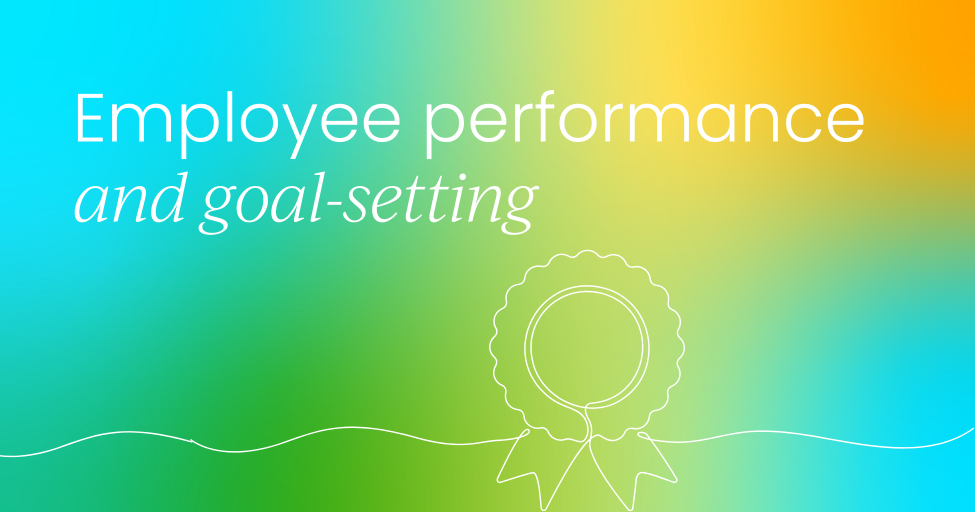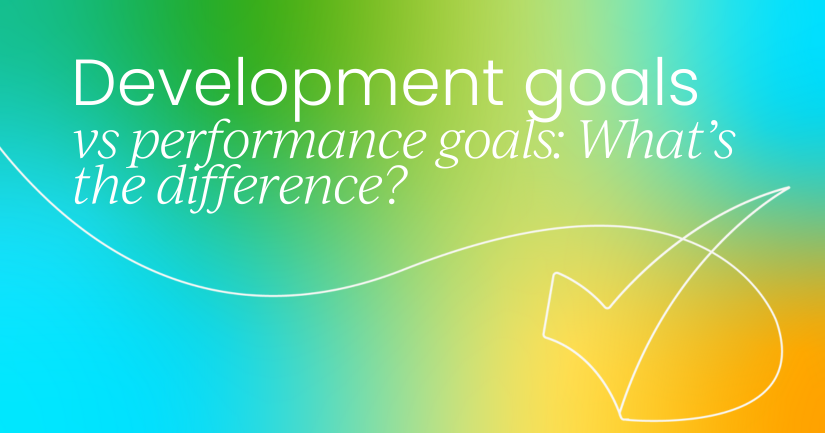As people leaders, we're experts at setting goals, but it's time to ask the all-important question… are we setting the right kind of goals?
The most effective people leaders understand that there are two sides to every goal: the "what" and the "who." This is the crucial difference between development goals vs performance goals. While one is about what your team needs to deliver, the other focuses on who they’re becoming.
In this article, we'll break down the distinction between development goals vs performance goals further, share some practical examples of both, and give you the strategies to help your team accomplish any goal they set for themselves.
What is the difference between performance goals vs development goals?
At first glance, it might seem like all work goals are pretty much the same. We set them, we work towards them, and we (hopefully!) achieve them. But when you look closer, there’s a fundamental difference in their purpose and focus.
Performance goals are about achieving specific business outcomes, while development goals are about growing the individual's capabilities and potential.
What are performance goals?
Simply put, performance goals are tied directly to the results an employee needs to deliver for the company. They're about the output, the quantifiable achievements, and how an individual contributes to the company's immediate success. These are often things that are measurable, time-bound, and directly impact the business's bottom line.
For example, hitting sales targets, completing a project on time and under budget, or reducing customer service response times are all classic examples of employee performance goals.
They answer the question: "What do you need to do to help the company succeed now?" Performance goals are often tied to job descriptions, team objectives, and strategic company priorities.

What are development goals?
Now, development goals are a different thing entirely. Instead of focusing on what an employee needs to achieve, they focus on who an employee needs to become. These goals are all about enhancing skills, knowledge, and personal attributes that will help an employee grow in their role, prepare for future opportunities, or simply become more effective and well-rounded in their career.
Development is less about the immediate task and more about long-term potential. These goals might involve things like learning a new software, improving communication skills, developing leadership qualities, or even gaining a deeper understanding of another department's functions.
When thinking about setting new development goals, consider your answer to this question: "What do I need to learn or improve to grow as a professional?" The payoff here might not be immediate, but it builds incredible value over time, both for the employee setting the goal and the organization.
The main difference between development vs performance goals is that performance goals are about doing the job well, while development goals are about getting better at the job (or preparing for the next job). Both are important, but for very different reasons.
Why both types of goals are important
So, if performance goals are all about the "what" and development goals are all about the "who," which one should you prioritize?
The answer is simple: you can't have one without the other.
Truly effective people leaders know that a balanced approach is the only way to build a high-performing, resilient, and engaged team.
Performance goals provide a clear roadmap for success, ensuring that every team member understands their role in achieving company objectives. They’re important because they:
- Provide clarity and focus: They translate big-picture company strategy into specific, actionable targets for individuals and teams. Research shows that employees with clear goals are also 8.1 times more likely to proactively seek out ways to improve their work, highlighting their role in fostering a culture of continuous improvement.
- Drive business results: They’re directly tied to the bottom line, helping you achieve key metrics like hitting sales targets or completing projects on time.
- Ensure accountability: They create a sense of ownership and responsibility, helping everyone understand their contribution to the company's success.
While performance goals handle the present, development goals future-proof your people and your organization.
By investing in an individual's skills and career growth, you’re showing them you care about more than just their current output. They are important because they:
- Increase engagement and morale: When employees feel invested in, they are more motivated, loyal, and committed to their work. In fact, employees who have clearly defined goals are 3.6 times more likely to remain committed to their organization.
- Boost employee retention: People are far more likely to stay with an organization that helps them learn and grow, which is a huge win for talent management.
- Build capacity and adaptability: Focusing on growth helps your team gain the skills needed to tackle new challenges and stay ahead of the curve.
Performance goal examples
As we've discussed, performance goals are all about the "what." They’re typically SMART (Specific, Measurable, Achievable, Relevant, Time-bound) and tied directly to the output an employee is expected to deliver.
Speaking of setting goals, our SMART goals template provides a simple, repeatable framework for creating meaningful goals that stick and deliver.
Here are a few examples of employee performance goals across different roles:
For a Sales Manager: "Increase the team's Q4 sales revenue by 15% compared to Q3."
For a Marketing Coordinator: "Launch three new blog posts per week for the next quarter to increase website traffic by 20%."
For a Customer Success Associate: "Improve the average customer satisfaction (CSAT) score by 5 points by the end of the quarter."
For a Project Manager: "Complete the rollout of the new software feature within the agreed-upon timeline and budget by October 31st."

Development goal examples
Now, let's shift our focus to the "who." Unlike the specific, numbers-driven nature of the performance goal examples above, development goals are about building skills and capabilities that will serve an employee over the long haul. They can be a bit more qualitative, focusing on personal and professional growth.
Here are some examples that highlight the core difference in development vs performance goals:
For a Junior Designer: "Complete an advanced Figma course to improve UI/UX skills and earn a certification within six months."
For a New Team Lead: "Lead a team retrospective meeting each week to develop skills in active listening and facilitation."
For an Engineer: "Spend two hours per week with the customer support team to better understand common user pain points and improve problem-solving skills."
For a People Operations Coordinator: "Develop presentation skills by volunteering to present a 'new hire's guide to benefits' at the next three onboarding sessions."
How to implement development vs. performance goals
Now that we understand the difference between development vs performance goals, the next step is implementation.
It's not enough to simply set them; a balanced approach requires a thoughtful and integrated process. The goal is to create a culture where both are seen as equally important and not just during a yearly review, but in every conversation.
Here’s how you can make it happen:
Establish a clear framework
Don't leave goal setting to chance. It’s good practice to come up with a clear, company-wide framework for how to approach both types of goals. This ensures consistency and provides a shared language for managers and employees.
For instance, you could use a simple template or a dedicated software tool to help people set, track, and review goals throughout the year.
Integrate the conversation
Don't treat performance goals and development goals as separate check-box exercises. The most powerful conversations happen when you discuss them together.
Ask questions that link the two: "Your goal is to increase Q4 sales by 15% (performance goal). What new skill (like advanced negotiation or data analysis) could you develop to help you achieve that (development goal)?
By connecting the "what" with the "who," you create a clear path forward that feels meaningful to the employee.
Model the behavior
As a leader, you set the tone. Show your team that you believe in a balanced approach by sharing your own examples of employee performance goals and development goals.
This is a behavior of high performers. According to Forbes, high-level executives are a remarkable 91% more likely to step outside their comfort zone in the pursuit of ambitious goals. So, when people see that their senior leaders are actively focused on both delivering results and growing their own skills, it sends a powerful message that this is a core part of the company culture.
Focus on consistency, not just annual reviews
A yearly conversation is a good starting point, but true growth happens over time. In fact, those who review goals quarterly generate 31% greater returns than those who only review goals annually.
So, it’s worth using your weekly or bi-weekly one-on-ones to discuss progress on both sets of goals. This provides opportunities for real-time coaching, removes roadblocks, and shows your team that their growth is a continuous priority, not just a once-a-year topic.
Provide the right resources
A goal without a plan is just a wish. For every development goal, discuss the resources needed to achieve it. This could be a mentorship, a training budget, an online course, or simply dedicated time to work on a new project.
Showing that you're willing to invest in their growth turns a goal from an expectation into a shared partnership.
Want to put these goal-setting strategies into action?
Become a People Alliance Insider Member and get free access to our library of resources.
You’ll find ready-to-use HR templates, customizable goal-setting plans, and more to help you build a truly high-performing team.



 Follow us on LinkedIn
Follow us on LinkedIn


